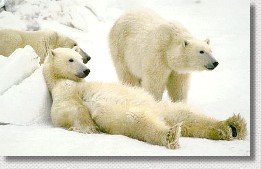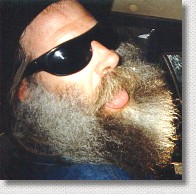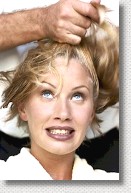Hair and fur can be found only on mammals, and all mammals have at least some hair or fur on their bodies at some time in their lives. On this page we're going to look closely at human and mammal hair. Hair follicles are often next to a sebaceous gland, which releases oil to lubricate and protect the hair shaft. The follicle holding the hair shaft is also connected to a small muscle, called an arrector pili muscle, which can cause the hair to stand erect, and which also pulls down the skin into a little pocket. This is what happens when you get 'goosebumps'. Animals can control this muscle ... a dog can make its hairs bristle out, and a porcupine can raise its quills ... but humans can't. It's an involuntary muscle. At the bottom, under the skin inside the follicle, the hair root produces the cells that form the living part of the hair. This all happens inside the bulb. This new growth pushes the cells that already exist up and out from the follicle. As the hair is pushed upwards through the skin, the hair loses its DNA and becomes just a strand of proteins. This protein strand (the hair you comb or brush) is not living tissue. The only living parts of hair are the cells within the hair follicle, under the skin. The colour of hair is determined, just like your skin, by how much melanin is in the cortex of the hair. Melanin is a protein, and there are several kinds; one of them is a pigment (it has a dark colour). Black hair has lots of this pigment; white hair has none.  Animals actually have several kinds of hair, or fur. Guard hairs lay over the inner fur to protect it. Sometimes these guard hairs can be very unusual. For example, the guard hairs on a porcupine are its spines. On a lion, some of the guard hairs are long and thick, on its mane. The guard hairs of a polar bear are translucent, allowing light to penetrate to the skin. Animals actually have several kinds of hair, or fur. Guard hairs lay over the inner fur to protect it. Sometimes these guard hairs can be very unusual. For example, the guard hairs on a porcupine are its spines. On a lion, some of the guard hairs are long and thick, on its mane. The guard hairs of a polar bear are translucent, allowing light to penetrate to the skin. Underneath a mammal's guard hairs is the fur, which can be three kinds ... underfur (which is always growing), regular fur that is short, and velli (down, or fuzz). Animals also have hairs called vibrissae, or whiskers. These are straight and stiff, and are connected to nerves below the skin which are very sensitive. They provide the animal with information about its immediate surroundings. Most hair on humans and animals is continually being shed, or lost, as it falls out. This is called molting, and humans do it too! An animal may shed all its hair in just a few weeks, which will be replaced by hair of a different colour or texture, perhaps because it is becoming an adult, or perhaps in preparation for a change in the weather. They do this only in certain seasons. In humans, however, hairs fall out only a few at a time, and all year long. Hairs are constantly molting and being replaced. What is hair for? Here are some reasons why animals have thick, coloured hair:
 The hair we do have comes in many different forms: scalp hair, facial hair, body hair, armpit hair, and pubic hair. But mostly human skin is now relatively hair-free, compared to animals. Various types of body hair are different in structure and chemical make-up. Hair also varies in shape, length, and rate of growth. For example, scalp hair or male facial hair is not at all like the fine, downy hair found on the face of infants or females. Sunlight, hormones, temperature, and nutrition all affect the rate of hair growth and its strength, as does body location ... for example, head hair grows fastest, about a third of a millimetre per day, or a centimetre per month. Let's look at some hair close up ...
Hair is also very elastic. When it is wet and squeaky, it will stretch along its length by as much as 30% without damage. It also absorbs water, causing it to swell. However, both elasticity and moisture content is lower in black curly hair than in lighter colours.
Some of hair's stiffness also comes from weaker chemical bonds which form between the molecules of keratin on the outer surface scales. Breaking these bonds will also allow you to change the hair's curl. This can be done simply by wetting the hair, and then fastening it into the desired shape as it dries. Wetting the hair again, however, even just humidity in the air, will allow the hair to return to its original shape as the keratin molecular bonds rejoin. Sometimes when a hair stops growing, part of the root dies, and the shaft breaks off. The hair may fall out, or be pushed out by the next hair growing from the follicle. Normally, up to 100 head hairs are shed each day. So some of that shed hair in your brush is quite normal. But head hair will last a long time before it naturally dies and falls out ... sometimes up to 5 years. When newly growing hair on the head doesn't appear as fast as hair is shed, the number of hairs on the head starts to decrease, eventually leading to hairless (bald) areas. Sometimes we want to remove hair from the body. Mens' facial hair is of course removed by shaving. Hair on other parts of the body can be shaved, and can also be removed by applying a cream designed for the purpose. The effects of unwanted facial hair in women can be lessened by applying a prescription cream called eflornithine, which slows its growth. (It interferes with an enzyme in the skin that regulates hair growth). Hair on other parts of the body can be forcefully 'yanked out' by plucking, or by using hot wax. Ouch! More Hair Facts:
|
 Hair can be reshaped by styling, using a strong chemical, which will break the chemical bonds that keep the wall of the hair shaft stiff. Shaping can be done when this happens, giving the hair a curl, or straightening it, as desired. Afterwards, another chemical is added to neutralize the original one, and to allow the bonds to form again in a new configuration.
Hair can be reshaped by styling, using a strong chemical, which will break the chemical bonds that keep the wall of the hair shaft stiff. Shaping can be done when this happens, giving the hair a curl, or straightening it, as desired. Afterwards, another chemical is added to neutralize the original one, and to allow the bonds to form again in a new configuration.